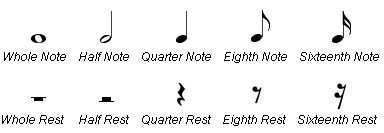

The rest of the note should be written in a small “1” above the E on the staff, as shown in the preceding example. The symbol appears on the note itself as an alternative to a shorter rest. As an example, if the first note in this example is preceded by an E, the remainder after that is a small “1” next to the letter E. Rests are typically written as small symbols near the note on which they will be played in standard notation.
#Musical whole rest how to#
How To Read And Write Rests In Musical Notation The four pause markings that you should be familiar with are general pause, fermata, caesura, and breath mark.

The time spent in a half-rest would be divided into two beats of silence. Parts that are absent from a musical notation sheet would have multiple bars of rest written on it. In addition, pause intervals are marked as appropriate, and the performer or conductor makes the final decision. A whole rest is equal to four beats of silence. Rests come in a variety of shapes and sizes, some of which can last for a long time. Rests are frequently used to indicate the end of a piece of music. A whole rest is represented by a large oval with a line through it, a half rest is represented by a small circle with a line through it, a quarter rest is represented by a small square with a line through it, and an eighth rest is represented by a small diamond with a line through it. Rests are notated using symbols that look like the corresponding note values, except that they have a line through them. A whole rest is a silence lasting for the duration of four beats, a half rest lasts for half that time, a quarter rest lasts for a quarter of the time, and an eighth rest lasts for an eighth of the time. The most common rests are whole rests, half rests, quarter rests, and eighth rests. In music, rests are gaps of silence of different lengths. The sixteenth note also has a rest, but it is a difficult note to play. The eighth rest is more difficult to count because it occurs faster than other rests. There’s no need to count them because quarter rests last only one beat.

Rests, according to popular belief, instruct musicians to stop playing for quarter notes, eighth notes, and sixteenth notes. You should be able to play the next set of notes with your fingers and hands when you’re done resting. During a whole rest and half rest, you are asked to pause for the same number of beats. Each note length contains a corresponding rest. Just be sure to use them sparingly, as too many rests can make a piece of music sound choppy.Ī musical rest is simply a pause in which you do not play music. Now that you know how to write different musical rests, you can use them to add interest and variety to your compositions. So if you see a half rest in a measure with a 4/4 time signature, you would know that you would need to take a two-beat pause. When it comes to timing, just remember that the duration of a rest is relative to the note value that it replaces. And for an eighth rest, draw a rectangle with a slash through it. For a whole rest, draw the rectangle below the line. To write a half rest, simply draw a rectangle on the line where the note would go. There are also half rests, whole rests, and eighth rests, among others. A quarter rest lasts for one beat, so if you see a quarter rest in a measure that has a 4/4 time signature, you would know that you would need to take a one-beat pause. The most common type of rest is the quarter rest, which is represented by a filled-in black rectangle. For example, a whole rest lasts for the duration of four beats, while a half rest lasts for two beats, and so on. And just as with notes, the duration of a rest is relative to the note value that it replaces. Just as there are different types of notes, there are also different types of rests. Most people don’t think about how to write different musical rests, but it’s actually a pretty simple process.


 0 kommentar(er)
0 kommentar(er)
